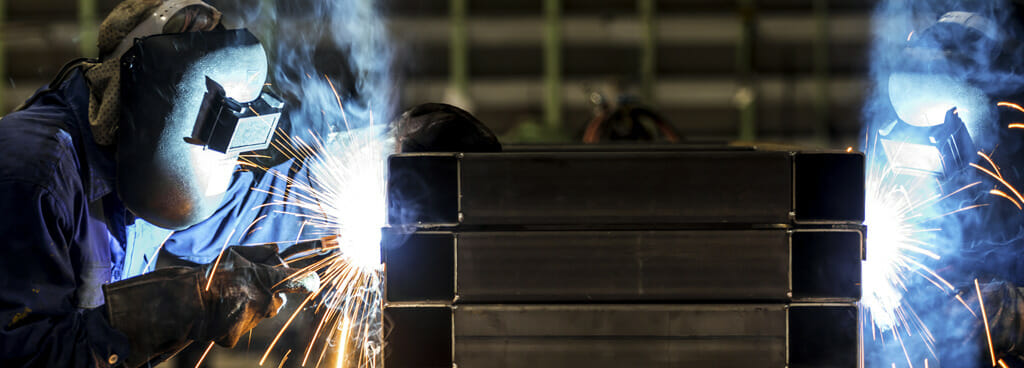- Home
- Services/IndustriesServicesindustries
- About Us
- LocationsStatesAccordion ContentAccordion ContentAccordion ContentAccordion Content
- Job Openings
- Quick Links
- ATS Family

3G Weld Test
A 3G weld test from ATS uncovers flaws in a weld, its materials, and the welder’s process. Welds can take on a combination of types, positions, and joints. The most common weld types are fillet (F) and groove (G) welds that combine two materials. Groove welds fill the space between two materials for maximum strength. For any weld type, the welding position and joint shape can impact the weld’s difficulty. The four main weld positions are:
- 1 - Flat
- 2 - Horizontal
- 3 - Vertical
- 4 - Overhead
Thus, a 3G weld has a vertical groove connection formed when a welder moves the electrode uphill or downhill to fuse two materials along a joint. While 3G welding can produce welds with similar quality to horizontal and flat welding, the welder must work slowly and against gravity when penetrating the joint between thick materials.
Welder Observations
ATS can certify welders, welds, and welding processes. Our clients typically request a certified weld inspector (CWI) to observe the practices and output of a welder before hiring. Manufacturers want welders who will be cautious and attentive when welding to avoid injury, defective welds, and liability in case of catastrophic failure. Vertical welding is a complicated process with an increased risk of injury from dripping or spattering molten metal.
ATS employs a team of American Welding Society (AWS)-certified weld inspectors who can observe a welder throughout the welding process for code compliance, safety measures, and technique. Some of the most common weld techniques include:
- Flux-Cored Arc Welding (FCAW)
- Gas Metal Arc Welding (GMAW)
- Gas Tungsten Arc Welding (GTAW)
- Stick or Shielded Metal Arc Welding (SMAW)
Weld Testing Methods
ATS weld inspector can test whether a weld meets standards and codes through various methods. We offer nondestructive inspections such as:
Our weld inspectors can also perform destructive weld tests to evaluate a weld’s characteristics and strength before failure. When conducting macro etch testing, an inspector etches a weld sample with an acidic solution to reveal defects in the weld, surface, and heat-affected zone. Another common weld service is transverse tension testing, where an inspector exposes the specimen to tension perpendicular to the grain until failure occurs, usually at the weld joint. During guided bend testing, the inspector bends the specimen over a radius longitudinally or transverse to the weld axis to determine integrity and strength.
Weld Test Specifications
Weld inspectors from ATS can tailor their evaluations to meet a client’s needs. For instance, an inspector can confirm if a welder follows standards from organizations such as ASME, AWS, ISO, API, MIL-STD, PED, and EN. Our weld lab also allows inspectors to identify potential damages and weld characteristics, such as:
- Defects
- Leaks
- Porosity
- Slag
- Strength
- Tightness
- Undercutting
- Weaknesses
- Weld material distribution
About ATS
ATS began in 1967 as a local engineering firm. Over fifty years later, we are a leading provider of consulting engineering, calibration, inspections, and testing services. Our commitment to high-quality service from educated and experienced professionals gives customers speedy responses, accurate test results, and detailed reports to inform business decisions.
ATS leads a Family of Companies that supports national and international industries, including aerospace, pulp and paper manufacture, and power generation. With locations across the nation, it is more convenient than ever for customers to reach a local ATS service provider.
Our headquarters in Marietta, Georgia, is home to a laboratory complex capable of custom engineering tests and analyses daily. The ATS emphasis on safety and standard compliance has earned the attention of certification bodies such as A2LA and NADCAP. We are also an accredited company for the CPSC, ITAR, and FAA. To learn more about our certifications and standards, click here.
Contact Us
Call +1 (888) 287-5227 or complete the request form on this page for weld tests from AWS-certified inspectors today.

Request Form
"*" indicates required fields
Weld Testing Links
- 1G Weld Test
- 2F Weld Test
- 2G Weld Testing
- 3G MIG Welding Test
- 4G Welding Certification
- 6G Welding Certification
- ASME Sect IX Testing
- AWS D1.1 Testing
- AWS D1.2 Testing
- AWS D17.1 Testing
- Certified Welding Inspectors
- Cut and Etch Weld Testing
- Destructive Weld Testing
- Fillet Weld Break Testing
- Fillet Weld Fracture Test
- Fillet Weld Test
- Fillet Weld Testing
- Macro Etch Testing
- Macro Etch Weld Test
- Macro Etch Weld Testing
- Pipeline Inspection Companies
- Pipe Weld Testing
- SMAW Welding Certification
- Spot Weld Testing
- Structural Steel Welding Certification
- Stick Welding Certification
- Visual Weld Testing
- Weld Engineering Company
- Weld Analysis
- Weld Bend Testing
- Weld Break Testing
- Weld Hardness Testing
- Weld Inspections
- Weld Inspections Services
- Weld Joint Testing
- Weld Notch Toughness Testing
- Weld Procedure Qualifications
- Weld Tensile Testing
- Weld Testing
- Weld Testing Services
- Weld Qualification Testing
- Welder Certification
- Welder Qualification
- Welding Certification
- Welding Certification Test
- Welding Engineering
- Welding Inspector
- Welding Test Coupon
- Welding Testing Lab
- Weld Testing Services
- WPS Qualified Welding Procedure
- WPS Welder Qualifications
